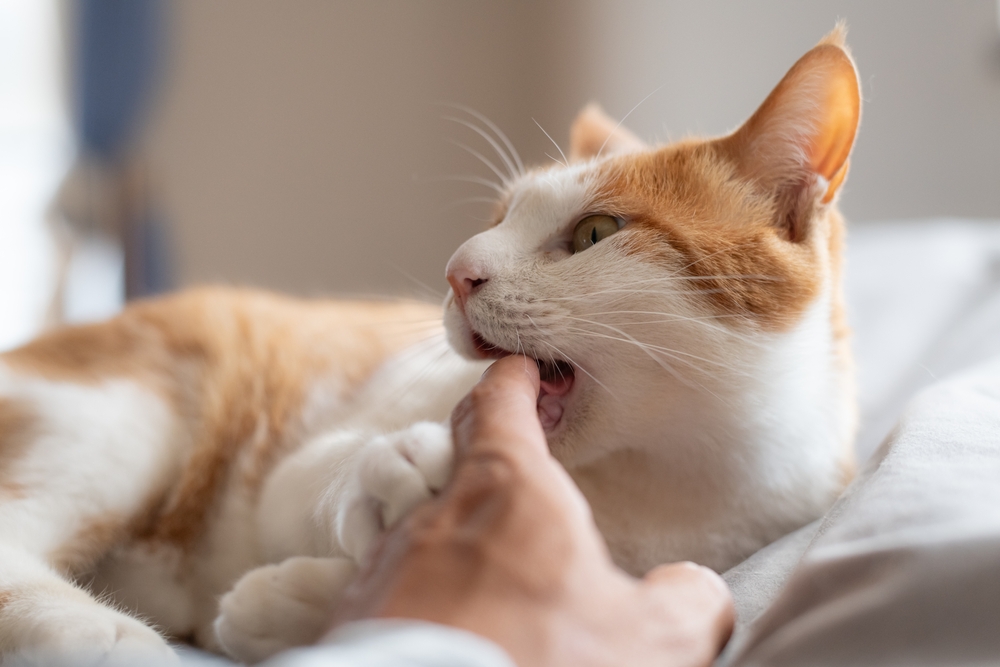Understanding Love Bites in Cats: Reasons Behind This Behavior! Learn why your feline nibbles, what it means, and how to respond. Strengthen your bond today!
Understanding Love Bites in Cats
Cats have intricate ways of expressing their feelings. One such behavior is the infamous love bite. If you’ve ever been gently nipped by your feline friend, you may have experienced a love bite. Despite what its name might imply, a love bite isn’t always a sign of affection. Here’s a deep dive into what cat love bites are and why your feline friend might be giving you one.
What Are Cat Love Bites?
Cats use their mouths for a lot more than eating and grooming. They communicate with their teeth. A love bite typically feels more like a gentle nibble than an aggressive bite. It’s common during petting sessions or playtime when your cat might suddenly nip at you softly. Originally, this behavior can be traced to the ways cats interact with each other.
Reasons Cats Give Love Bites
- Overstimulation: Cats can become overstimulated from too much petting or handling. Even if your cat enjoys being petted, there often comes a point where it’s had enough. The love bite is a way to communicate that it needs a break.
- Play Behavior: Cats are playful creatures and teeth are part of play. Love bites are reminiscent of how kittens interact. They bite each other when play fighting, training their hunting skills.
- Attention Seeking: Sometimes a love bite could simply be a call for attention. Cats learn that giving a gentle nip can make you react. This can include giving them more pets or playing with them.
- Affection Display: Despite what it sounds like, sometimes a love bite is indeed a sign of affection. Cats use various techniques to show their love and bonds, including mouth-related actions.
Distinct from Aggressive Biting
Understanding the difference between a love bite and an aggressive bite is crucial. Love bites are softer and don’t break the skin. They usually follow petting or calm interaction. On the other hand, an aggressive bite is harder and often follows warning signs such as hissing or growling. It’s important to observe your cat’s body language. Ears back, tail flicking, or twitching skin can be indicators that a line is about to be crossed.
How to Respond to Love Bites
Reacting appropriately to a love bite helps maintain a positive relationship with your cat. If your cat is biting due to overstimulation, try to recognize when it’s had enough. Look for signs like tail flicking or a change in vocalization.
If it’s because your cat wants attention, you can redirect the behavior with toys or interactive play. Avoid reinforcing the biting by giving immediate attention right after being nipped. Instead, offer attention after it has shown more constructive behavior.
Showing affection in ways that don’t involve overstimulation can also help. Focus on finding the sweet spot where your cat enjoys petting without reaching its threshold.
Training Tips to Manage Love Bites
- Positive Reinforcement: Reward your cat for gentle interactions without biting. Use treats or affection as rewards for good behavior.
- Redirection: If you notice biting becoming excessive, redirect your cat’s focus to toys or other objects they can safely bite on.
- Consistency: Make sure all family members respond similarly to love bites. This consistency in responses helps cats understand which behaviors are acceptable.
- Recognize Limits: Learn and respect your cat’s boundaries to prevent pushing them into biting.
Why Some Cats Don’t Love Bite
Not all cats exhibit love bites. Variations in personality, breed traits, and socialization experiences affect whether a cat will use love bites as a form of communication. Some cats might show affection in other ways, like purring or gentle headbutts. Age can also be a factor. Kittens might bite more during play while older cats may have different methods for showing what they want.
Understanding Your Cat Better
Cats are complex creatures, each with unique personalities. Love bites are just one aspect of their multifaceted behavior. Observing and understanding what triggers your cat’s love bites can enhance your relationship. Pay attention not only to the bite but the context surrounding it. This awareness helps build a stronger bond with your feline companion.
Conclusion
In navigating your cat’s love bites, the key is balance and observation. Engaging with your cat on their terms and understanding when they need space or attention can prevent miscommunication. It’s about building trust and understanding between you and your furry friend.

